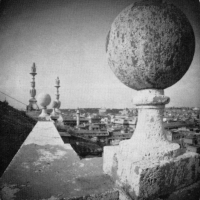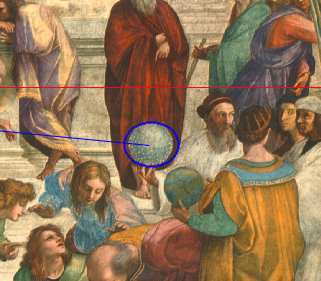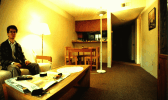Correction of geometric perceptual distortions in pictures


Left: Wide-angle pinhole photograph taken on the roof of the Church
of St. Ignatzio in Rome, classical example of perspective distortions from
the book M. Pirenne "Optics, painting and photography." ; reprinted
with the permission of Cambridge University Press.
Right: Corrected version of the picture with transformation applied.
Summary
The process of realistic image synthesis can be subdivided into two
stages: modeling the physics of light propagation in three-dimensional
environments and projecting the geometry of three-dimensional space into
the picture plane (the "viewing transformation.")
While the first stage is relatively independent of our understanding
of visual perception, the viewing transformations are based on the fact
that we are able to perceive two-dimensional patterns - pictures - as reasonably
accurate representations of three-dimensional objects. We can evaluate
the quality of modeling the propagation of light objectively, by comparing
calculated photometric values with experimental measurements. For viewing
transformations the quality is much more subjective.
The perspective projection is the viewing transformation that has been
primarily used for producing realistic images, in art, photography and
in computer graphics.
One motivation for using perspective projection in computer graphics
is the idea of photorealism: since photographic images have one of the
highest degrees of realism that we can achieve, perhaps realistic rendering
should model the photographic process.
But the intuitive concept of realism in many cases differs from photorealism:
photographic images, are often perceived as distorted (note the shape of
the sphere in the photo from M. Pirenne's book above. On the other hand,
some paintings such as Rafael's "School of Athens" shown below,
while using perspective projection, contain considerable deviations from
it. These paintings, however, are perceptually correct and realistic.


Top: "School of Athens" with lines showing reconstruction
of the center of projection. Bottom: a fragment of the painting
showing a sphere; the blue outline is the calculated projection of the
sphere. Note that it is quite different from the depicted shape.
We derive viewing transformations from some basic principles of perception
of pictures rather than by modeling a particular physical process of picture
generation. Our approach is based on formalizations of desirable perceptual
properties of pictures as mathematical restrictions on viewing transformations.
The main result allows us to construct usable families of transformations;
it is a decomposition theorem which states that under some assumptions,
any perceptually acceptable picture-independent viewing transformation
can be decomposed into a perspective or parallel projection and a two-dimensional
transformation.
Our approach allows us to achieve several goals:
- We construct new viewing transformations that reduce distortions that
appear in perspective projection images.
It turns out that some of these transformations can be implemented as
a postprocessing stage after perspective projection and can be applied
to existing images and photos.
- We provide a basis for understanding limitations of two-dimensional
images of three-dimensional space; certain perceptual distortions can be
eliminated only at the expense of increasing other distortions.
- Our transformation works well in animations and movies.
- Our families of transformations can be modified or extended by adding
or removing auxiliary perceptual requirements; this provides a general
basis for constructing pictures with desirable perceptual properties.
The transformations that we propose may have a number of applications:
creation of computer-generated wide-angle pictures and wide-angle animations
with reduced distortion, and correction of photographic images and movies.



A wide-angle photograph of a room.
Left: Original image (approximately 100 degrees field of view)
Middle: Correcting transformation applied with maximal correction
for shape distortion everywhere.
Right: Correcting transformation applied, maximal correction of
distortion of shape on the left, decreasing to the right across the image.
Note the correct shape of the head and straightness of the walls.

 Details of the original and corrected photographs.
Details of the original and corrected photographs.
Distortion in moving images becomes even more objectionable. Follow
the next link to see some examples.
More details can be found in my MS
Thesis
and in the paper
Zorin, Denis and Alan H. Barr, ``Correction of geometric perceptual
distortions in pictures,'' in Proceedings of SIGGRAPH 1995, ACM
SIGGRAPH, 1995, pp. 257-264.
Abstract Compressed
Postscript (8.1 Mb)








